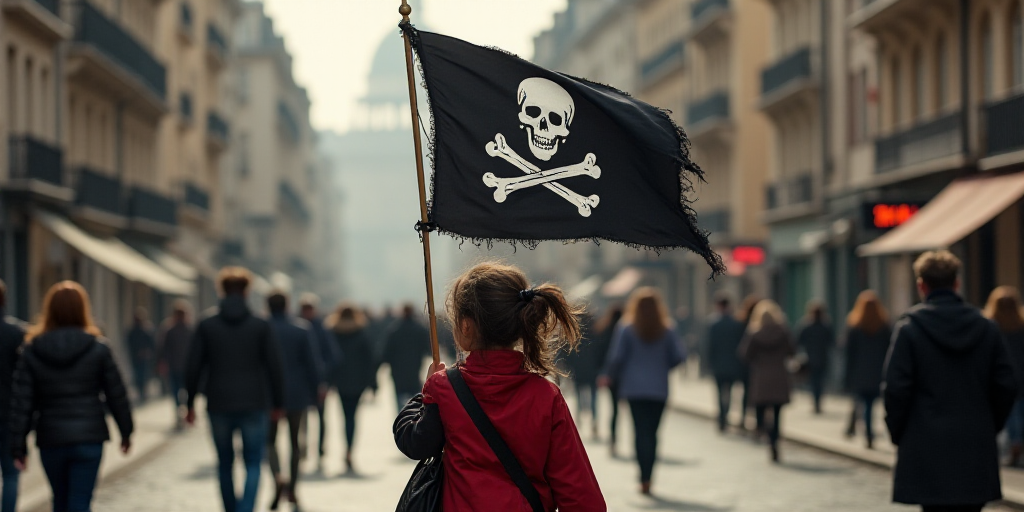From Peru to Nepal, from the Philippines to France: The Flag of Luffy and His Crew
With his straw hat and defiant smile, Luffy, the nemesis of corrupt governments and hero of One Piece, the most sold manga in history, has become a global symbol of youth protest against bad governance wherever it exists.
From Peru to Nepal, from the Philippines to France, the flag representing Luffy and his crew —a grinning skull with a straw hat and crossed bones, similar to the classic Jolly Roger pirate flag— has flown recently in anti-system demonstrations worldwide.
A Symbol Against Oppression and Corruption
Those who wave it see it as an emblem against oppression and corruption, and also as a generational unity signal for twenty-somethings who grew up with One Piece, the series dating back to 1997.
“I grew up with One Piece, just like the majority of Generation Z, so it has become a symbol for us,” said Kai, a 26-year-old who joined protests in Madagascar due to constant water and electricity cuts that exhausted locals.
For Kai —he goes by a pseudonym— the series carries a clear message of fighting against “oppressive governments”.
The same is said by Wildar Lozano, a 19-year-old student from Peru, who explained to AFP that the flag represents Luffy and his crew, who “go from village to village liberating [citizens] from a corrupt government, a government that does not represent them, an authoritarian government”.
“In Peru, politicians fill their pockets with the people’s money. And that’s what we see so far. There are politicians who cannot properly represent, which is my personal belief,” added Leonardo Muñoz, 19, a student at the Pontificia Universidad Católica del Perú, where protests against the government and against the wave of extortions and murders by organized crime have also been registered in recent weeks.
The flag of Luffy and his crew was first seen waving above the heads of young protesters during anti-government protests in Indonesia at the end of August, and even the government threatened to ban it.
Fighting Against the ‘World Government’
In the cult series by Japanese artist Eiichiro Oda —with over 100 mangas—, Monkey D. Luffy sails the seas fighting to become the King of the Pirates.
On his journey, Luffy stops at various islands —inspired by real countries including Egypt, Spain, and Japan— and fights to put an end to the oppressive rule of the World Government.
The books also carry an ecological message.
An Epic, Universal Quest
The story is an epic “universal quest,” according to Phedra Derycke, author of the book “One Piece: Lessons of Power”.
“It’s a series that has lasted over 20 years, sold hundreds of millions of copies worldwide, and transmits ideals of dreams and freedom,” said Derycke.
“Behind the accessible pirate adventure, Oda develops many political themes: a ruling class that exploits the people, slavery, discrimination, racism,” explained Derycke, who sees echoes of One Piece scenes in recent anti-government protests like those in Nepal, Indonesia, Madagascar, or Peru.
According to Derycke, Luffy’s flag is a “depoliticized” symbol adaptable to protests in various scenarios.
A Unifying Manga
The emblem also appeared recently in French protests and was a fresh face among labor union familiar banners.
A teacher carrying Luffy’s flag in the city of Lyon, Julien Dubon, 45, said he was sharing what “the youth of Asia (…) started.”
“This (flag) will reach more people than those flags you see behind me,” said Dubon, referring to the union banners. “They (flags) might speak more to certain generations (older ones) and perhaps less to others,” he added.
Anthropologist Elisabeth Soulie, author of a book about Generation Z, sees Luffy’s flag as an “emotional” and “unifying” symbol for young people who typically mobilize collectively through social media, lacking clear leadership.
Those same networks, said Derycke, can amplify the popularity of the pirate flag in future protests worldwide.
Key Questions and Answers
- Q: Who is Luffy, and why is he relevant? A: Luffy is the protagonist of “One Piece,” the best-selling manga series globally. He symbolizes resistance against corrupt governments and has become a global youth protest symbol.
- Q: How does One Piece relate to current protests? A: The series, created by Eiichiro Oda, contains political themes like fighting against oppressive governments and exploitative ruling classes, resonating with recent protests in various countries.
- Q: What makes Luffy’s flag a unifying symbol? A: The flag, depoliticized and adaptable to various scenarios, has become a unifying symbol for Generation Z protesters worldwide, transcending age and geographical boundaries.






